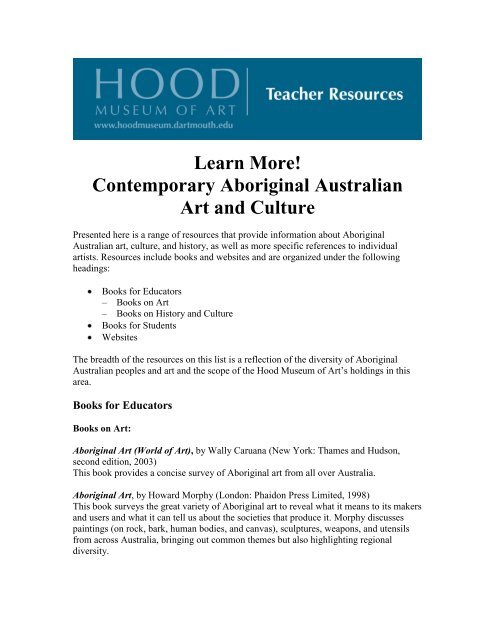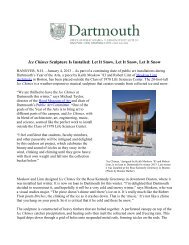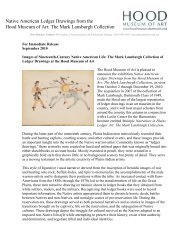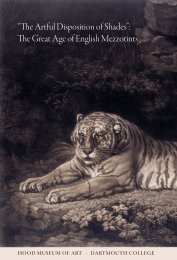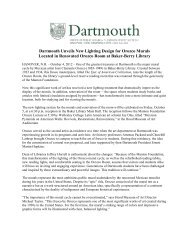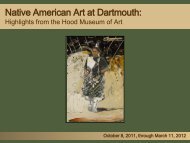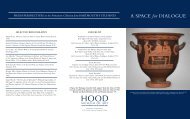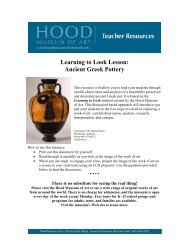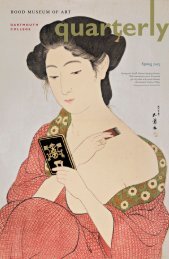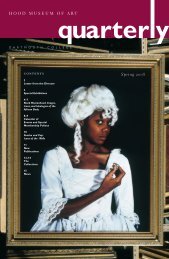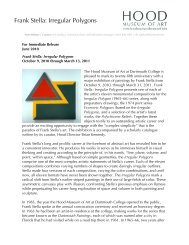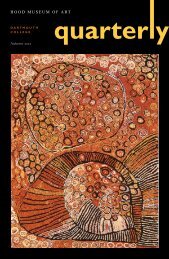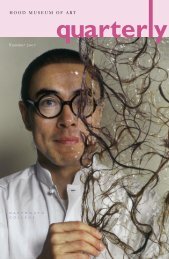Learn More! Contemporary Aboriginal Australian Art and Culture
Learn More! Contemporary Aboriginal Australian Art and Culture
Learn More! Contemporary Aboriginal Australian Art and Culture
Create successful ePaper yourself
Turn your PDF publications into a flip-book with our unique Google optimized e-Paper software.
<strong>Learn</strong> <strong>More</strong>!<br />
<strong>Contemporary</strong> <strong>Aboriginal</strong> <strong>Australian</strong><br />
<strong>Art</strong> <strong>and</strong> <strong>Culture</strong><br />
Presented here is a range of resources that provide information about <strong>Aboriginal</strong><br />
<strong>Australian</strong> art, culture, <strong>and</strong> history, as well as more specific references to individual<br />
artists. Resources include books <strong>and</strong> websites <strong>and</strong> are organized under the following<br />
headings:<br />
Books for Educators<br />
– Books on <strong>Art</strong><br />
– Books on History <strong>and</strong> <strong>Culture</strong><br />
Books for Students<br />
Websites<br />
The breadth of the resources on this list is a reflection of the diversity of <strong>Aboriginal</strong><br />
<strong>Australian</strong> peoples <strong>and</strong> art <strong>and</strong> the scope of the Hood Museum of <strong>Art</strong>’s holdings in this<br />
area.<br />
Books for Educators<br />
Books on <strong>Art</strong>:<br />
<strong>Aboriginal</strong> <strong>Art</strong> (World of <strong>Art</strong>), by Wally Caruana (New York: Thames <strong>and</strong> Hudson,<br />
second edition, 2003)<br />
This book provides a concise survey of <strong>Aboriginal</strong> art from all over Australia.<br />
<strong>Aboriginal</strong> <strong>Art</strong>, by Howard Morphy (London: Phaidon Press Limited, 1998)<br />
This book surveys the great variety of <strong>Aboriginal</strong> art to reveal what it means to its makers<br />
<strong>and</strong> users <strong>and</strong> what it can tell us about the societies that produce it. Morphy discusses<br />
paintings (on rock, bark, human bodies, <strong>and</strong> canvas), sculptures, weapons, <strong>and</strong> utensils<br />
from across Australia, bringing out common themes but also highlighting regional<br />
diversity.
<strong>Aboriginal</strong> <strong>and</strong> Torres Strait Isl<strong>and</strong>er <strong>Art</strong>: Collection Highlights from the National<br />
Gallery of Australia (Canberra, <strong>Australian</strong> Capital Territory: National Gallery of<br />
Australia, 2010)<br />
The National Gallery of Australia holds the largest collection of <strong>Australian</strong> Indigenous art<br />
in the world. This exhibition catalogue is written by Indigenous authors <strong>and</strong> curators <strong>and</strong><br />
other experts in the field. It features 183 works of art that highlight the diversity <strong>and</strong><br />
variety of <strong>Aboriginal</strong> <strong>Australian</strong> art.<br />
Ancestral Connections: <strong>Art</strong> <strong>and</strong> an <strong>Aboriginal</strong> System of Knowledge, by Howard<br />
Morphy (Chicago: University of Chicago Press, 1992)<br />
Ancestral Connections looks into the inner meaning of <strong>Australian</strong> <strong>Aboriginal</strong> bark<br />
painting. Morphy draws on more than ten years of fieldwork among the Yolngu—an<br />
<strong>Aboriginal</strong> people of Northeast Arnhem L<strong>and</strong>—<strong>and</strong> applies both anthropological <strong>and</strong> art<br />
historical methods to explore the graphic representation of traditional knowledge in<br />
Yolngu art. He also charts the role that art has played in <strong>Aboriginal</strong> society, both present<br />
<strong>and</strong> past.<br />
Ancestral Modern: <strong>Australian</strong> <strong>Aboriginal</strong> <strong>Art</strong>: Kaplan <strong>and</strong> Levi Collection, by Pamela<br />
McClusky et al. (Seattle: Seattle <strong>Art</strong> Museum; Yale University Press, 2012)<br />
This catalogue for the exhibition at the Seattle <strong>Art</strong> Museum (May 31–September 2, 2012)<br />
features over one hundred artworks from the late twentieth to early twenty-first centuries,<br />
including paintings on canvas, ochres on bark, <strong>and</strong> sculptures carved of wood, woven of<br />
fiber, <strong>and</strong> cast in bronze.<br />
<strong>Art</strong> + Soul: A Journey into the World of <strong>Aboriginal</strong> <strong>Art</strong>, by Hetti Perkins (Carlton,<br />
Victoria: Miegunyah Press, 2010)<br />
Hetti Perkins takes readers on a personal journey of discovery into a world of ideas <strong>and</strong><br />
the imagination of leading <strong>Aboriginal</strong> artists around Australia as she travels from the<br />
Arnhem L<strong>and</strong> to Sydney <strong>and</strong> from saltwater country to the desert heartl<strong>and</strong>s of Central<br />
Australia.<br />
<strong>Australian</strong> <strong>Art</strong>, by Andrew Sayers (Oxford: Oxford University Press, 2001)<br />
This survey examines the interaction between <strong>Aboriginal</strong> art <strong>and</strong> that of European<br />
<strong>Australian</strong>s. Painting, bark art, photography, rock art, sculpture, <strong>and</strong> the decorative arts<br />
are all fully explored to present the rich texture of <strong>Australian</strong> art traditions.<br />
Australia’s Living Heritage: <strong>Art</strong>s of the Dreaming, by Jennifer Isaacs (Sydney:<br />
L<strong>and</strong>sdowne, 1989)<br />
This book looks at the evolving style <strong>and</strong> variety of <strong>Aboriginal</strong> <strong>Australian</strong> art over time.<br />
It covers rock art, body art, fiber <strong>and</strong> weaving, <strong>and</strong> the Papunya painting movement with<br />
illustrations of the ground-painting techniques.<br />
Beyond Sacred: Recent Paintings from Australia’s Remote <strong>Aboriginal</strong> Communities:<br />
The Collection of Colin <strong>and</strong> Elizabeth Laverty (Melbourne, Victoria: Hardie Grant,<br />
2008)
Colin <strong>and</strong> Elizabeth Laverty began collecting <strong>Aboriginal</strong> art more than twenty years ago.<br />
They have traveled widely in central, western, <strong>and</strong> northern Australia <strong>and</strong> repeatedly<br />
visited various <strong>Aboriginal</strong> communities. This book is a comprehensive survey of<br />
<strong>Australian</strong> <strong>Aboriginal</strong> art today. It features the work of internationally renowned artists<br />
such as Rover Thomas, Emily Kngwarreye, <strong>and</strong> John Mawurndjul, as well as newer<br />
artists.<br />
Country <strong>Culture</strong> Community: An Education Kit for the <strong>Aboriginal</strong> <strong>and</strong> Torres Strait<br />
Isl<strong>and</strong>er Collection (Sydney, New South Wales: <strong>Art</strong> Gallery of New South Wales, 2009)<br />
This kit helps students underst<strong>and</strong> <strong>and</strong> appreciate the richness <strong>and</strong> diversity of <strong>Aboriginal</strong><br />
<strong>and</strong> Torres Strait Isl<strong>and</strong>er art through key works in the collection. In focusing on<br />
significant artists or groups of artists <strong>and</strong> their work, this resource provides an<br />
introduction to the many forms of Indigenous art practices <strong>and</strong> related issues <strong>and</strong> ideas.<br />
How Aborigines Invented the Idea of <strong>Contemporary</strong> <strong>Art</strong>: Writings on <strong>Aboriginal</strong><br />
<strong>Contemporary</strong> <strong>Art</strong>, by Ian McLean et al. (Sydney, New South Wales: Institute of Modern<br />
<strong>Art</strong> <strong>and</strong> Power Publications, 2011)<br />
This is the first anthology to chronicle the global critical reception of <strong>Aboriginal</strong> art since<br />
the early 1980s, when the art world began to underst<strong>and</strong> it as contemporary art. Featuring<br />
ninety-six authors–including art critics <strong>and</strong> historians, curators, art center coordinators<br />
<strong>and</strong> managers, artists, anthropologists, sociologists, philosophers, <strong>and</strong> novelists–it<br />
conveys a diversity of approaches.<br />
Icons of the Desert: Early <strong>Aboriginal</strong> Paintings from Papunya, by Roger Benjamin<br />
(Ithaca, N.Y.: Cornell University Press, 2009)<br />
This exhibition catalog was produced by the Herbert F. Johnson Museum of <strong>Art</strong> at<br />
Cornell University for a show featuring forty-nine "dot paintings" produced by<br />
<strong>Aboriginal</strong> artists from the settlement of Papunya. Dot painting has become an art<br />
instantly associated with <strong>Aboriginal</strong> Australia. In the more than thirty-five years since the<br />
advent of this movement, Papunya works have been widely exhibited <strong>and</strong> acquired by<br />
private collectors <strong>and</strong> museums in Australia, <strong>and</strong> increasingly abroad.This catalogue<br />
focuses on the founding expressions of Papunya art. It examines their origins in the<br />
paintings produced in Papunya in the Western Desert during the years 1971 to 1973, after<br />
the Sydney schoolteacher Geoffrey Bardon provided <strong>Aboriginal</strong> men with art materials<br />
<strong>and</strong> encouraged them to paint on Masonite, against the wishes of <strong>Australian</strong> government<br />
officials.<br />
Images of Power: <strong>Aboriginal</strong> <strong>Art</strong> of the Kimberley, by Judith Ryan, Frances Kofod, <strong>and</strong><br />
Kim Ackerman (Melbourne, Victoria: National Gallery of Victoria, 2006)<br />
This publication from the National Gallery of Victoria gives in-depth coverage of<br />
<strong>Aboriginal</strong> art from the Kimberley Region. Placing the work in its cultural context, the<br />
texts explore how traditional beliefs <strong>and</strong> contemporary events fuse to produce a vibrant<br />
art.<br />
L<strong>and</strong>Marks: Indigenous <strong>Australian</strong> <strong>Art</strong> in the Nation, by Judith Ryan (Melbourne,<br />
Victoria: Council of Trustees of the National Gallery of Victoria, 2006)
This catalogue documents the L<strong>and</strong>Marks exhibition at the National Gallery of Victoria<br />
in 2006. It features full-color plates, a location map, <strong>and</strong> essays by Judith Ryan <strong>and</strong><br />
others.<br />
One Sun One Moon: <strong>Aboriginal</strong> <strong>Art</strong> in Australia, edited by Hetti Perkins <strong>and</strong> Margie<br />
West Theresa Willsteed (Sydney, New South Wales: <strong>Art</strong> Gallery of New South Wales,<br />
2007)<br />
From rock shelters dating back 20,000 years to politically inspired contemporary prints,<br />
the artwork of <strong>Aboriginal</strong> cultures is recognized for its mastery, beauty, <strong>and</strong> cultural<br />
significance. Drawing from The <strong>Art</strong> Gallery of New South Wales, the Holmes Court<br />
Collection, Heytesbury, <strong>and</strong> the <strong>Art</strong> Gallery of the Northern Territory, this volume<br />
features contributions by twenty-five of the field's leading scholars as well as sixteen<br />
interviews with key contemporary artists.<br />
Our Way: <strong>Contemporary</strong> <strong>Aboriginal</strong> <strong>Art</strong> from Lockhart River, by Sally Butler (St.<br />
Lucia, Qld.: University of Queensl<strong>and</strong> Press, 2007)<br />
The unique art of the Lockhart River community, Australia’s only youth-driven<br />
<strong>Aboriginal</strong> art initiative, is collected for the first time in this stunning anthology.<br />
Information about the people <strong>and</strong> places that influence the community’s artwork is<br />
combined with striking images of numerous individual pieces. Though it draws upon<br />
ancient spiritual traditions, this artwork also shows the global scope of <strong>Aboriginal</strong><br />
cultural expression today.<br />
Papunya: A Place Made After the Story: The Beginnings of the Western Desert<br />
Painting Movement, by Geoffrey Bardon <strong>and</strong> James Bardon (Carlton, Victoria: Lund<br />
Humphries Publishers, 2006)<br />
Papunya: A Place Made After the Story is a first-h<strong>and</strong> account of the artists <strong>and</strong> the<br />
works emanating from Papunya. Geoffrey Bardon's exquisitely recorded notes <strong>and</strong><br />
drawings are reproduced here, showing his extensive documentation of the early stages of<br />
the painting movement. This book features over five hundred paintings, drawings, <strong>and</strong><br />
photographs from Bardon's personal archive.<br />
Possessions: Indigenous <strong>Art</strong>/Colonial <strong>Culture</strong>, by Nicholas Thomas (New York:<br />
Thames <strong>and</strong> Hudson, 1999)<br />
This book examines the process of cross-cultural exchange <strong>and</strong> the relationship between<br />
contemporary Indigenous art <strong>and</strong> modern Western art.<br />
Ricky Maynard: Portrait of a Distant L<strong>and</strong> (Sydney, New South Wales: Museum of<br />
<strong>Contemporary</strong> <strong>Art</strong>, Sydney, 2008)<br />
This catalogue features the photographic works by documentary photographer Ricky<br />
Maynard, encompassing more than two decades of the artist’s practice. These sixty<br />
evocative <strong>and</strong> captivating photographic works document a broad range of themes <strong>and</strong><br />
issues facing <strong>Aboriginal</strong> <strong>and</strong> Torres Strait Isl<strong>and</strong>er people today.<br />
Tjukurrtjanu: Origins of Western Desert <strong>Art</strong> (National Gallery of Victoria, 2011)<br />
The Papunya artists’ bold initial experiments, in committing ceremonial designs that are
Tjukurrtjanu (from the Dreaming) onto board, marked the beginning of a modern<br />
painting movement that would change the face of <strong>Australian</strong> art forever. Drawing on the<br />
expertise of leading anthropologists, art historians, <strong>and</strong> field officers, Tjukurrtjanu offers<br />
insightful perspectives on the artists <strong>and</strong> the iconography of their complex <strong>and</strong> intimate<br />
paintings.<br />
Books on History <strong>and</strong> <strong>Culture</strong>:<br />
<strong>Aboriginal</strong> Title <strong>and</strong> Indigenous Peoples: Canada, Australia, <strong>and</strong> New Zeal<strong>and</strong>, by<br />
Louis A. Knafla <strong>and</strong> Haijo Jan Westra (Vancouver: UBC Press, 2010)<br />
This book explores legal developments in regards to l<strong>and</strong> <strong>and</strong> title rights in former British<br />
colonies. It offers new perspectives on <strong>Aboriginal</strong> title that extend beyond national<br />
borders to consider similar developments in common law countries.<br />
Australia’s <strong>Aboriginal</strong> Heritage, by Jean A. Ellis (East Melbourne: HarperCollins, 1999)<br />
This book provides a general account of traditional culture (sacred, material, <strong>and</strong> social),<br />
contact history, <strong>and</strong> contemporary issues. It includes an appendix on the Wiradjuri with a<br />
wordlist <strong>and</strong> songs <strong>and</strong> contemporary poems.<br />
<strong>Australian</strong> Dreaming: 40,000 Years of <strong>Aboriginal</strong> History, by Jennifer Isaacs (Sydney,<br />
New South Wales: Ure Smith Press, 1992)<br />
This book provides a history of the <strong>Australian</strong> continent <strong>and</strong> its people, as told by<br />
<strong>Aboriginal</strong> storytellers. It recounts epic travels of the Great Spirit Ancestors <strong>and</strong> tells how<br />
they created the animals <strong>and</strong> plants <strong>and</strong> gave birth to the earliest people of this l<strong>and</strong>.<br />
Bush Food: <strong>Aboriginal</strong> Food <strong>and</strong> Herbal Medicine, by Jennifer Isaacs (Sydney, New<br />
South Wales: L<strong>and</strong>sdowne, 1987)<br />
In pre-colonial eras, <strong>Aboriginal</strong> people enjoyed a balanced, varied diet of fruits, nuts,<br />
roots, vegetables, meat, <strong>and</strong> fish. In this book, Isaacs uncovers the variety <strong>and</strong> quality of<br />
their culinary experience.<br />
Books for Students:<br />
<strong>Aboriginal</strong> <strong>Australian</strong>s: First Nations of an Ancient Continent, by Stephen Muecke <strong>and</strong><br />
Adam Shoemaker (London: Thames <strong>and</strong> Hudson, 2004)<br />
The book explores Indigenous <strong>Australian</strong> culture <strong>and</strong> traditions, looking back to ancestral<br />
beginnings while also devoting space to art <strong>and</strong> culture in the past four decades.<br />
Recommended for grades 4–12, adults.<br />
And a Kangaroo Too (Canberra, <strong>Australian</strong>: National Gallery of Australia, 1997)<br />
A collection of images of animals in <strong>Australian</strong> <strong>Aboriginal</strong> art, including goannas,<br />
magpie geese, crocodiles, emus, possums, <strong>and</strong> turtles. Each double page introduces, with<br />
its <strong>Aboriginal</strong> names, a painted animal from the Dreamtime taken from <strong>Aboriginal</strong> art.<br />
Recommended for grades K–2.
Animal Dreaming, by Paul Morin (New York: Harcourt Brace <strong>and</strong> Company, 1998)<br />
This is a story about an <strong>Aboriginal</strong> <strong>Australian</strong> boy coming of age. Author Paul Morin<br />
tells a story of friendship <strong>and</strong> tradition as he introduces the reader to the customs <strong>and</strong><br />
traditions of this particular culture group. Recommended for grades 2–6.<br />
Bayagul: <strong>Contemporary</strong> Indigenous Communication, by Steve Miller (Sydney,<br />
Australia: Powerhouse Publishing, 2002)<br />
Bayagul means “Speaking Up” in the Eora language of the Sydney area, <strong>and</strong> this book<br />
looks at the ways in which Indigenous <strong>Australian</strong>s are speaking up for themselves in film,<br />
tourism, fashion, the media, <strong>and</strong> the performing arts. Discover what motivates <strong>and</strong><br />
inspires a range of talented <strong>Aboriginal</strong> <strong>Australian</strong> people <strong>and</strong> Torres Strait Isl<strong>and</strong>ers.<br />
Recommended for grades 4–12, adults.<br />
From the Dreaming: Dreaming Stories from <strong>Aboriginal</strong> Australia, by Jean A. Ellis<br />
(Sydney, Australia: Harper Collins Publishers, 2002)<br />
In From the Dreaming, Jean Ellis has chosen a collection of stories from the different<br />
areas of Australia. These stories reflect the vivid imagination, strong sense of drama, <strong>and</strong><br />
intimate underst<strong>and</strong>ing of nature that is characteristic of the <strong>Aboriginal</strong> people of<br />
Australia. Recommended for grades 4–12, adults.<br />
Gadi Mirrabooka: <strong>Australian</strong> <strong>Aboriginal</strong> Tales from the Dreaming, edited by Helen F.<br />
McKay (Englewood, Colorado: Libraries Unlimited, a Division of Greenwood Publishing<br />
Groups, Inc., 2002)<br />
The stories in this book are presented with approval from <strong>Aboriginal</strong> <strong>Australian</strong> elders in<br />
an effort to help foster a better underst<strong>and</strong>ing of the history <strong>and</strong> culture of <strong>Aboriginal</strong><br />
peoples. Gadi Mirrabooka, which means below the Southern Cross, introduces wonderful<br />
tales from the ancestral beginnings. Through these stories you can learn about customs<br />
<strong>and</strong> values, animal psychology, hunting <strong>and</strong> gathering skills, cultural norms, moral<br />
behavior, spiritual belief system, survival skills, <strong>and</strong> food resources of many <strong>Aboriginal</strong><br />
<strong>Australian</strong> peoples. Recommended for grades 4–12, adults.<br />
The Flying Emu <strong>and</strong> Other <strong>Australian</strong> Stories, by Sally Morgan (New York: Viking<br />
Penguin, 1992)<br />
Dedicated by the author to “all the naughty children in the world,” this book contains<br />
twenty lively original stories, replete with the mythic stuff of wonder tales–magic,<br />
transformation, resurrection, eating alive, disgorging, <strong>and</strong> other comically earthy<br />
workings of the digestive tract–all recounted in an engaging <strong>and</strong> accessible style.<br />
Recommended for grades 2–6.<br />
Websites:<br />
http://qagoma.qld.gov.au/education/education_resources/past_education_resources<br />
The website for The Queensl<strong>and</strong> <strong>Art</strong> Gallery/Gallery of Modern <strong>Art</strong> (QAGOMA) has a<br />
number of resources from a variety of past <strong>and</strong> current exhibitions.<br />
http://www.ngv.vic.gov.au/ngvschools/TraditionAndTransformation/
The National Gallery of Victoria’s website on Indigenous art from their collection has<br />
been created for educators to use in their classrooms. This website has artworks, stories,<br />
photographs, maps, <strong>and</strong> videos from Indigenous peoples <strong>and</strong> artists, as well as classroom<br />
activities <strong>and</strong> teacher resources.<br />
http://www.seattleartmuseum.org/ancestralmodern/<br />
This link provides web links, books, <strong>and</strong> classroom resources for the Seattle <strong>Art</strong><br />
Museum’s exhibition of <strong>Aboriginal</strong> <strong>Australian</strong> art, Ancestral Modern: <strong>Australian</strong><br />
<strong>Aboriginal</strong> <strong>Art</strong>.<br />
http://aboriginalart<strong>and</strong>culture.wordpress.com/<br />
Will Owen, along with his partner Harvey Wagner, have been collectors of<br />
<strong>Aboriginal</strong> <strong>Australian</strong> art since the late 1980s. In June 2010, Owen <strong>and</strong> Wagner<br />
donated four hundred works of art to the Hood Museum of <strong>Art</strong>.<br />
This blog is written by Will Owen. It provides readings, reviews, <strong>and</strong> reflections on<br />
<strong>Australian</strong> Indigenous art, culture, politics, anthropology, music, <strong>and</strong> literature.<br />
A note about the following websites:<br />
<strong>Art</strong> <strong>and</strong> culture centers exist in many <strong>Aboriginal</strong> <strong>Australian</strong> communities <strong>and</strong> serve a<br />
number of functions. They are a place to learn about <strong>Aboriginal</strong> <strong>Australian</strong> art <strong>and</strong><br />
culture, they serve as galleries <strong>and</strong> places for artists to show <strong>and</strong> sell their work, <strong>and</strong> they<br />
are often hubs for community activity <strong>and</strong> economic sustainability. The websites listed<br />
below are region-specific art centers that provide information on the history of these<br />
communities <strong>and</strong> the art that they have created.<br />
http://www.papunyatula.com.au/<br />
Papunya Tula <strong>Art</strong>ists is entirely owned <strong>and</strong> directed by traditional <strong>Aboriginal</strong> people<br />
from the Western Desert. The aim of the company is to promote individual artists, to<br />
provide economic development for the communities to which they belong, <strong>and</strong> to assist in<br />
the maintenance of a rich cultural heritage.<br />
http://www.maningrida.com/<br />
Maningrida <strong>Art</strong>s & <strong>Culture</strong>, owned by Bawinanga <strong>Aboriginal</strong> Corporation <strong>and</strong> formally<br />
established in 1973, is one of the oldest <strong>Aboriginal</strong> arts centers in Australia. Based in<br />
Maningrida community, MAC is currently servicing more than 250 artists from<br />
Maningrida <strong>and</strong> its surrounding 34 outstations, covering an area of more than 10,000<br />
square kilometers.<br />
http://www.tiwiart.com/<br />
The Tiwi <strong>Art</strong> Network is an alliance between the three art centers on the Tiwi Isl<strong>and</strong>s:<br />
Munupi <strong>Art</strong>s & Crafts, Tiwi Design, <strong>and</strong> Jilamara <strong>Art</strong>s & Crafts.<br />
http://www.warlu.com/<br />
Warlukurlangu <strong>Art</strong>ists' <strong>Aboriginal</strong> Corporation is a fully <strong>Aboriginal</strong>-owned <strong>and</strong><br />
governed art center. One hundred percent of the proceeds from the sale of all art works
go directly back to the artists <strong>and</strong> their community projects. Warlukurlangu means<br />
"belonging to fire" in Warlpiri; it is named after a Fire Dreaming west of Yuendumu.<br />
Owned <strong>and</strong> governed by its more than 600 members, Warlukurlangu art center is famous<br />
for its gloriously colorful acrylic paintings <strong>and</strong> fine limited-edition prints. Many of its<br />
members' works are highly collectable.<br />
Established in 1985, Warlukurlangu <strong>Art</strong>ists' <strong>Aboriginal</strong> Corporation has a well-regarded<br />
international profile. <strong>Art</strong>works have been featured in hundreds of exhibitions around the<br />
globe <strong>and</strong> have been reproduced in many publications.<br />
Located at Yuendumu, 300km northwest of Alice Springs in the Northern Territory, the<br />
art center is both a stronghold of traditional Warlpiri culture <strong>and</strong> an essential part of<br />
Yuendumu's community life.<br />
http://www.ankaaa.org.au/<br />
The Association of Northern Central <strong>Australian</strong> <strong>Aboriginal</strong> <strong>Art</strong>ists ("ANCAAA") was<br />
originally established in March 1987 by sixteen <strong>Aboriginal</strong>-owned <strong>and</strong> controlled<br />
community art <strong>and</strong> craft centers. Its main function was to foster the <strong>Aboriginal</strong> arts<br />
industry for the benefit of its artists <strong>and</strong> organizations. Today, ANKAAA represents up to<br />
5,000 artists from forty-nine art <strong>and</strong> craft centers located in the Tiwi Isl<strong>and</strong>s <strong>and</strong> the<br />
Darwin/Katherine, Kimberley, <strong>and</strong> Arnhem L<strong>and</strong> regions.<br />
http://www.balgoart.org.au/<br />
Warlayirti <strong>Art</strong>ists supports the art <strong>and</strong> culture of the Kutjungka region through the<br />
production <strong>and</strong> sale of fine Indigenous art <strong>and</strong> activities that provide opportunities for<br />
intergenerational knowledge transfer <strong>and</strong> learning.<br />
Warlayirti <strong>Art</strong>ists operates from a community development framework implementing<br />
community development principles <strong>and</strong> processes to maximize the participation of the<br />
Indigenous staff, committee, <strong>and</strong> artists in the organization.<br />
http://www.warmunart.com/<br />
Warmun artists are renowned for their use of natural ochre <strong>and</strong> pigments on canvas,<br />
which is integral to the contemporary expression of l<strong>and</strong> <strong>and</strong> culture as identity for Gija<br />
people. The work of Warmun artists is an inseparable <strong>and</strong> celebratory part of Gija culture<br />
<strong>and</strong> country <strong>and</strong> draws on traditional Ngarrangkarni (Dreaming) stories <strong>and</strong><br />
contemporary life. Warmun art has a national <strong>and</strong> international reputation, thanks to the<br />
leadership of highly successful Warmun artists like Rover Thomas <strong>and</strong> Queenie<br />
McKenzie, George Mung Mung, <strong>and</strong> Paddy Jaminji.<br />
http://www.koorieheritagetrust.com/<br />
The Koorie Heritage Trust aims to protect, preserve, <strong>and</strong> promote the living culture of<br />
<strong>Aboriginal</strong> people of southeastern Australia. Established in 1985, the trust is a not-forprofit<br />
<strong>Aboriginal</strong> community organization.


